The ASRock X99E-ITX/ac Review: Up to 36 Threads in Mini-ITX
by Ian Cutress on June 24, 2015 8:00 AM ESTCPU Performance
Readers of our motherboard review section will have noted the trend in modern motherboards to implement a form of MultiCore Enhancement / Acceleration / Turbo (read our report here) on their motherboards. This does several things, including better benchmark results at stock settings (not entirely needed if overclocking is an end-user goal) at the expense of heat and temperature. It also gives in essence an automatic overclock which may be against what the user wants. Our testing methodology is ‘out-of-the-box’, with the latest public BIOS installed and XMP enabled, and thus subject to the whims of this feature. It is ultimately up to the motherboard manufacturer to take this risk – and manufacturers taking risks in the setup is something they do on every product (think C-state settings, USB priority, DPC Latency / monitoring priority, memory subtimings at JEDEC). Processor speed change is part of that risk, and ultimately if no overclocking is planned, some motherboards will affect how fast that shiny new processor goes and can be an important factor in the system build.
For reference, the X99E-ITX/ac has Multicore Turbo disabled by default in BIOS P1.20. The important element to note here is if dual channel memory has an effect in performance.
Point Calculations – 3D Movement Algorithm Test: link
3DPM is a self-penned benchmark, taking basic 3D movement algorithms used in Brownian Motion simulations and testing them for speed. High floating point performance, MHz and IPC wins in the single thread version, whereas the multithread version has to handle the threads and loves more cores. For a brief explanation of the platform agnostic coding behind this benchmark, see my forum post here.

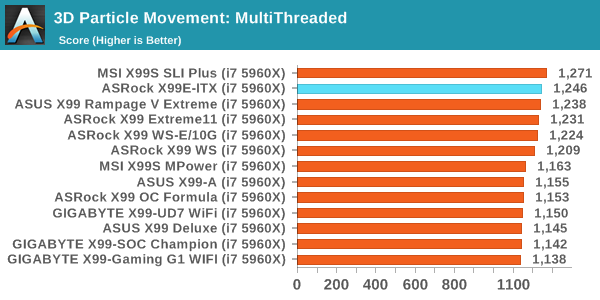
3DPM is not DRAM dependent, so dual channel memory has no issue here.
Compression – WinRAR 5.0.1: link
Our WinRAR test from 2013 is updated to the latest version of WinRAR at the start of 2014. We compress a set of 2867 files across 320 folders totaling 1.52 GB in size – 95% of these files are small typical website files, and the rest (90% of the size) are small 30 second 720p videos.
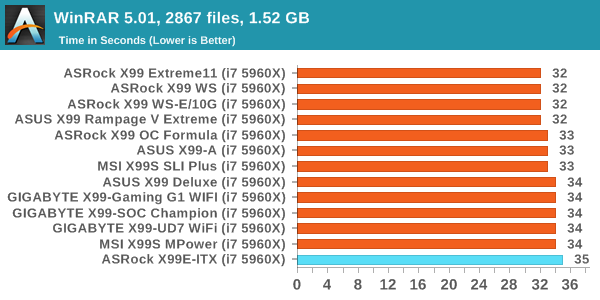
WinRAR is typically a benchmark that tackles DRAM, and we see that the dual channel orientation has a small detriment here.
Image Manipulation – FastStone Image Viewer 4.9: link
Similarly to WinRAR, the FastStone test us updated for 2014 to the latest version. FastStone is the program I use to perform quick or bulk actions on images, such as resizing, adjusting for color and cropping. In our test we take a series of 170 images in various sizes and formats and convert them all into 640x480 .gif files, maintaining the aspect ratio. FastStone does not use multithreading for this test, and thus single threaded performance is often the winner.
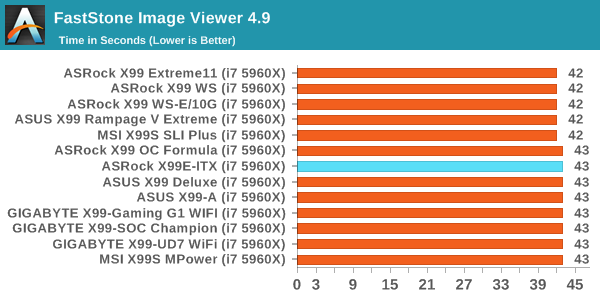
FastStone is a CPU benchmark, so no difference here.
Video Conversion – Handbrake v0.9.9: link
Handbrake is a media conversion tool that was initially designed to help DVD ISOs and Video CDs into more common video formats. The principle today is still the same, primarily as an output for H.264 + AAC/MP3 audio within an MKV container. In our test we use the same videos as in the Xilisoft test, and results are given in frames per second.
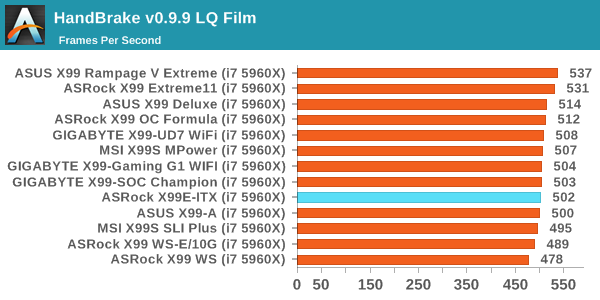

One would normally point at video conversion as requiring DRAM accesses, but we see a difference here between low quality conversion and high quality conversion. Using the larger frames we see that dual channel memory causes a ~10% drop in performance compared to other non-MCE enabled motherboards.
Rendering – PovRay 3.7: link
The Persistence of Vision RayTracer, or PovRay, is a freeware package for as the name suggests, ray tracing. It is a pure renderer, rather than modeling software, but the latest beta version contains a handy benchmark for stressing all processing threads on a platform. We have been using this test in motherboard reviews to test memory stability at various CPU speeds to good effect – if it passes the test, the IMC in the CPU is stable for a given CPU speed. As a CPU test, it runs for approximately 2-3 minutes on high end platforms.
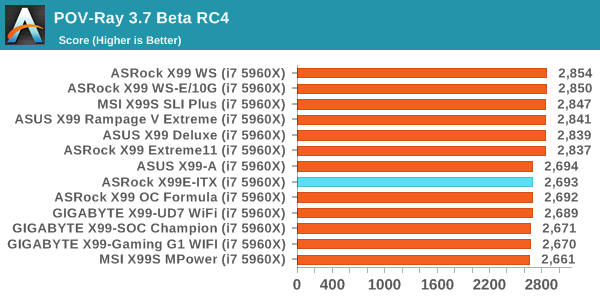
No changes for POV-Ray in dual channel.
Synthetic – 7-Zip 9.2: link
As an open source compression tool, 7-Zip is a popular tool for making sets of files easier to handle and transfer. The software offers up its own benchmark, to which we report the result.
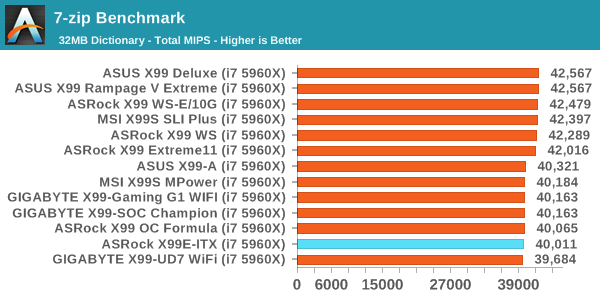
Similarly no difference in 7-zip.










56 Comments
View All Comments
mighty78 - Wednesday, June 24, 2015 - link
The title is wrong. Motherboard is 17cm x 17cm so it's surface area is 289 cm^2.Ian Cutress - Wednesday, June 24, 2015 - link
Yup, you're right. A mental hiccup - adjusted. :)Ancalagon44 - Wednesday, June 24, 2015 - link
Um where does the 36 threads come in? The CPU can only do 16?PaulMack - Wednesday, June 24, 2015 - link
It supports the 18-core Xeon X5-2699.mighty78 - Wednesday, June 24, 2015 - link
The board supports 18-core Xeon E5-2699 v3, though it was not used in this review.icrf - Wednesday, June 24, 2015 - link
I guess you could drop an 18-core Xeon E5-2699 v3 in there.cchalo - Wednesday, June 24, 2015 - link
Straight from the article "...where we can use up to 8 cores with consumer processors or 18 cores with Xeons – double the threads with hyperthreading as well"The CPU in question the E5-2699 V3 http://ark.intel.com/products/81061/Intel-Xeon-Pro...
shadarlo - Wednesday, June 24, 2015 - link
No USB-C on a board this high-end? Shame.Wardrop - Thursday, June 25, 2015 - link
You've got 8 usb ports on the back. Why would you want to make any Type-C connections? Hardly any peripherals use type-c, and those that do will probably benefit most from being plugged into the front I/O panel. Because you can, doesn't mean you should. Asrock has made the right choice here in order to maintain maximim compatibility.cenpjas - Monday, June 29, 2015 - link
I am more wondering why they bothered with USB 2.0 and I would of liked at least one USB 3.1 internal so I could hook it up to the front of my chassis and onto a USB type C.The selling point for me is the x4 M.2, the fact you lose that if you plug in a M-PCI card sux.